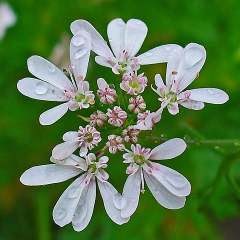Coriander
 Common Names: Chinese parsley or dhania
Common Names: Chinese parsley or dhania
Scientific Name: Coriandrum sativum
Climate: Temperate
Plant Description: It is an annual herb, growing 40 to 60 cm tall. Long stem with abundant small, pinnatisect,1 filiform, and toothed leaves forming a small rosette about 30 cm high. At the beginning of the flowering process, the stem branches and elongates until reaching a height of 60 to 70 cm. At the tips of the branches are the compound umbels, which present white to pink flowers and which give rise to a globular schizocarp (dried fruit), with two achenes, each containing one seed. The root system is made up of a thin taproot and fine , superficial secondary roots.
If the leaves are harvested, it is called cilantro. If the seeds are harvested, they are called coriander.
Cultivation: Full sun. The optimum temperature for cultivation of coriander is between 15-18ºC. The concentration of essential oil in the fruits decreases at temperatures above 21°C. It can thrive in cooler climates, although it is going to grow more slowly. The plant is not very demanding on soils, being able to grow on loamy, siliceous-clayey, somewhat calcareous, light, fresh, permeable, deep and even slightly acid soils, but preferring limestone. It normally grows in arid regions, but it can grow well when exposed to irrigation.
In temperate climates, the best time to start growing cilantro is in late spring. In tropical climates, coriander grows best during cool, and dry times of the year.
Coriander seed is propagated by direct sowing into the ground. It does not support transplantation with exposed roots. To facilitate the germination of the seeds the ground must be prepared by comminuition (about 20 cm deep). But the soil should not be finely pulverized,as they may form crusts that will make it difficult for the seedlings to germinate. The soil should be loose, deep and well drained. The seeds should be sown no deeper than 1.3 cm, using 6 to 12 seeds per 30 cm and in strips so that there is about 2.5 and 5 cm between plants. In crops that aim to produce seeds it is recommended to leave 13 to 15 cm between plants.
Watering begins after sowing. It requires 10 ml of water daily in its initial stage.2 The crop requires continuous soil moisture content but not too much. It does not need additional nutrients to those already made in the soil preparation. The seed germinates between 15 to 30 days.
When the plant reaches a height of approximately 15 cm, it can be cut whole or each leaf individually. You can uproot the entire plant or cut 2 cm from the ground and wait for a less vigorous regrowth. Ideally, sow it every 3 to 4 weeks to ensure a supply of fresh leaves.
In the summer, when temperatures are higher and there are more hours of sunlight, coriander tends to flower at an earlier age, which reduces leaf productivity, but speeds up seed production.
If you grow coriander for the seeds, wait for the fruit to turn brown and cut the entire plant. Place the plant in a paper bag and store it in a cool, dry place. Shake the bag so fruits open. You will see the seeds once you rub the fruits between the hands. Store seeds in closed containers. Dried leaves should be wrapped in plastic and stored in the refrigerator for one week.3
 Uses: It is an aromatic, fragrant, citric herb. Its fresh leaves and dried seeds are used in kitchens around the world.
Uses: It is an aromatic, fragrant, citric herb. Its fresh leaves and dried seeds are used in kitchens around the world.
It has medicinal properties: it contains important oils such as antioxidants, anti-infectives and detoxifiers, and vitamin C. Coriander helps lower bad cholesterol in the blood and eliminate fat, thus helping to prevent heart problems and tension. Helps relieve kidney problems. It is being used to treat indigestion and it is great support in absorption of nutrients. For diabetes, coriander stimulates insulin secretion, helping to level blood sugar.
Pests and diseases: Coriander has few diseases.
Most common pests: Aphids, leaf worms, whiteflies and mites. To prevent, make applications of a preparation of garlic, chili and neutral soap. In the case of the May beetles, apply 200 g / m2 of lime before sowing.
Most common diseases: Bacterial spot (Pseudomonas syringae). Keep the crop free of weeds, to avoid competition for light, water and nutrients. To prevent bacterial stain and leaf blight, apply a preparation of garlic and neutral soap via the foliage and on the ground with a watering can.
References:
- This is the name given to the pinnate vein sheet, when it is so deeply divided that the resulting segments reach the midrib.
- https://aprenderly.com/doc/3207191/carta-tecnol%C3%B3gica-para-el-cultivo-de-cilantro---inifap
- https://web.extension.illinois.edu/herbs_sp/cilantro.cfm
En español: Cilantro
